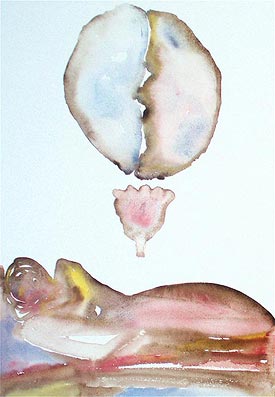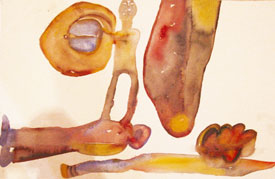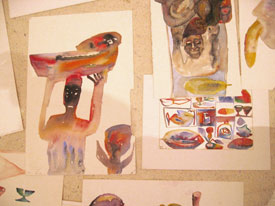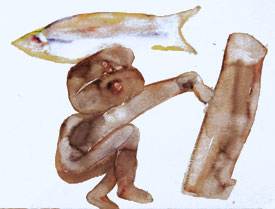
born 1949,
lives an works in Tripolis.
Picture: Archive of Dr. Landsteiner, 1995
Watercolours, 32 x 50 cm
Exhibition Galerie Anton Meier,
Geneva, September 2007.
By Jörg Mollet
“This sign here, well that’s a half moon – but the full moon’s only hinted at,” a youth explains to whom I’ve shown a watercolor by Ali Ezouik. Or, is a fruit, a shell (see watercolor 1, on the left)?
The delicately outlined circular form, filled with a light blue and crimson,floats powerfully above a sleeping figure, and between the two there’s a flower.The colors of star, flower and figure reflect each other. A golden yellow onthe contours of the reclining woman, here and there bright lights occur.
It’s the dreamer’s easiness that fascinates me, the metamorphosis, the powerof which seems to make all forms participate in each other; forms that couldbreak up at any moment now, give in into a new form. It cannot be the colorsalone, there must be lots of energy that forms things and signs and makes themshine.
Ali Ezouik’s works are the fruits of a long and arduous road. After having brokenwith earlier phases of creation a long period of crisis, of menacing burn-outfollow. All the while strong powers were at work, mutating and focusing an all-embracingknowledge, academic elements and tradition.
And now, there’s everything out, presented as unmistakable, authentic painting,“with intimacy, strong emotion and yet rather ascetic as to the purity and freshnessof colors,” as Ali Ezouik elaborates. He’s succeeded in breaking through fromthe inside to the outside. All channels are wide open. Now, even the light isflowing and runs through a world of signs in all directions: from an organ-likepatch to a fruit, from the organ to the flower, from the plant to the figure,from the torso to the vessel.
The artist dishes up plentifully. Could be a banquet; in any case, hospitalitypar excellence.
Another picture (watercolor 2, see on the left hand side): a reclining figureout of the chest of which grows another figure. This one’s grown together witha blue-golden fruit (or is it the globe?). Next to it a big, dark sign formedlike a fruit with red and yellow dots. At the bottom of this scene there’s aknife with a rainbow blade the tip of which is glowing. And a flower-like form’sgrowing out of it.
Here, one thing grows out of the other one, is linked in color and form. Whenfollowing this process in my thought, I’m arriving in the midst of some nature-likeexcessive growing. Everything becomes nature, paradisiacal.
The knife in the work of the artist testifies to existential boundaries, provenin the context of the heart, for instance, appearing as a sign and an organ.The blade cuts up the body, “opens it up”, the way anatomy and surgery has practicedsince Vesalius’ times.
Here, the artist does the same: he “opens up” and, from his experience, makesaccessible foreign worlds that have remained closed to us so far. The heart,well the whole figure turns into a fruit that’s being prepared.
And that’s not all: the woman with the fruit basket on top of her head (watercolor3, see left hand side) turns, in the following watercolor, into the woman carryingthe child’s basket. The scarlet red, the pink in the basket of the child flowsabove the head into the figure’s chest and on to a blue streaming in the stomach.Including the possibility of a vice versa.
Ali Ezouik is a painter, staying with his pictures. We might as well call hima “rainmaker” in the deepest sense who knows how to link the inside and the outside,top and bottom. In his world the tables are abundantly set with rare fruits –complementarily set in their colorfulness. To eat from them means to become whole.
More paintings: www.alizawik.4t.com





